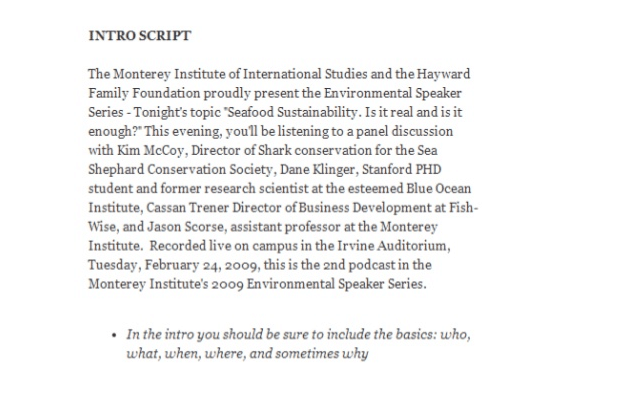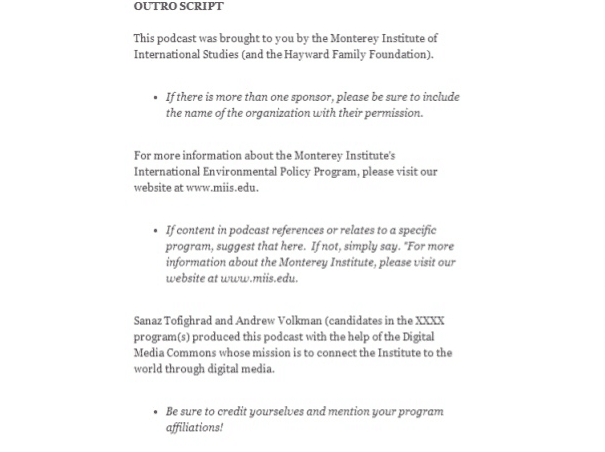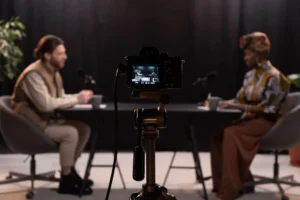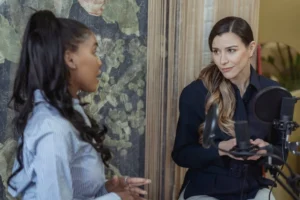Podcast intros and outros give your episodes polish and personality. They raise the production value of your show and help you compete with the other 750,000 podcasts.
What are podcast intros and outros? Want to know how to end a podcast? Frankly, you have a lot of flexibility here. Your intros and outros can be anything you want them to be, but most shows layer a short voiceover over background music.
Intros last about 30 seconds (but no more than a minute). They introduce the podcast’s name, a brief explanation of the show, and the host. Outros are usually simple “thanks for listening” messages with instructions on where to follow and subscribe. Together, these elements make your show professional, accessible, and valuable.
If you’re new to podcasting, just starting a podcast, or looking to add some polish to your show, keep reading to learn more about podcast intros and outros.
How to Start a Podcast: What Goes Into A Podcast Intro?
You only get one impression, so it’s important to nail the introduction by quickly creating a sleek, high value experience that convinces your listeners to invest their time. If you don’t impress people quickly, you’ll fail to capture new listeners and grow your podcast.
A great podcast intro, along with your cover art, makes a promise to your listeners. It explains the podcast’s purpose, introduces the speaker, and helps the listener understand the value they’ll receive by listening. Listeners will use the intro to decide if they’re willing to invest their time, so it’s important to be enticing without being deceptive.
Here are some elements every podcast intro needs:
- Podcast name – Drop your show’s name so people know what they’re listening to.
- Episode title – Just like an article, your title should go at the beginning.
- Episode number – This creates chronology and helps your readers match your audio content with your podcast show notes and audio transcription.
- Hosts names – Introduce yourself and any co-hosts quickly.
Here are some elements you may want to include, depending on your situation:
- Music – Brand your show with some special music that exhibits your personality.
- Tagline – Explain the purpose or general idea of your show (e.g. “A podcast that helps you boost your ecommerce sales.”)
- Network ID – If you’re part of a network, you might be required to state this.
- Recorded date – This helps if your content is time-sensitive or related to events.
- Sponsors – Depending on your deals with your sponsors, you may have to mention them in your intro and/or outro.
- Disclaimer – You might have some information you want every listener to know before they listen to your episode. You might warn them of spoilers, explain that your content doesn’t count as legal or medical advice, or let listeners know that you’ll be discussing a mature subject.
Here’s a sample of a great podcast intro. Notice how they state the name of the show, the series it’s part of, and the date because the topic is time-relative. They also introduce topic and the episode’s speaker, which means they record a unique intro for each episode.
Action
Read to start your own podcast? Learn the nitty-gritty details of starting your own show in our comprehensive guide. Learn how to start a podcast.
How to End a Podcast: What Goes Into A Podcast Outro?
Once you finish recording your first podcast segment, you’ll probably wonder how to end a podcast. You aren’t alone. Actually, a lot of new podcasters are uncomfortable wrapping up their show. There’s always the fear, “Did I say everything I need to produce a great episode?”
Ideally, you’ll want to build an outline before recording. This will help you organize your thoughts and make sure you cover everything. Your last points should serve the overall point of your episode. For instance, if you were interviewing a web designer about new design trends, your final question to your guest might be about where listeners can go to stay abreast of new styles, techniques, and trends. The sort of question gives your listeners somewhere to learn beyond your episode.
The podcast outro is where you break way from the episode’s subject and wrap up some podcast business. This is where you’ll complete your episode and drive listeners to take action. Your outro isn’t as critical to the success of your episode as your intro (many people will close out of your episode as soon as they hear the outro music), but it’s still an important part of a professional presentation.
You can use the same music as your intro, but you’ll want to record a new voiceover. Use this time to express your gratitude and ask your listeners to take action. You might ask them to…
- Leave a review on their favorite platform.
- Donate to your Patreon to support you financially.
- Leave a comment on the page (if they’re listening on your podcast website).
- Join your Facebook group or community.
- Buy merchandise, memberships, or courses.
- Remind your listeners when they can download your next episode.
Some podcasts like to change their outro regularly depending on the needs of their brand. For instance, they might switch from a “like us on Facebook” outro to a “donate to keep us going” outro once they open a Patreon.
Here’s a sample outro script. They smartly repeat the name of the show and tell you where to get more information. They also credit some important people.
Podcast Intros and Outros Examples
Need inspiration for your podcast intros and outros? Here are some great examples.
1. Smart Passive Income [Intro]
Pat Flynn runs an exceptionally well-polished show. He opens with a pre-intro (for lack of a better word) that states the name of his show, his name, and the episode number. Then the music starts and a narrator describes the show, why you should listen, and introduces the host.
2. Going Linux [Intro]
Like Smart Passive Income, Going Linux starts out with some basic information: Podcast name, episode number, and episode title. Music plays for a few seconds, then the hosts introduce themselves, the show, and its value.
3. Marketing Over Coffee [Intro]
This spartan introduction dives right into the music. A narrator announces the name of the show and its hosts. Very little fanfare here, but that approach could be right for your audience.
4. Are You Just Watching? [Intro]
Since this podcast discusses film, they start off with a quick disclaimer to warn you about spoilers. Next they mention their network and plug their sponsor before the music starts. The hosts state the episode number, title, and their own names.
5. This Week in Tech [Outro]
This podcast ends with the host explaining ways you can listen live, join their chat room, where to download it on demand, how to subscribe, and when to expect the next episode. Unlike many shows, they don’t use music.
6. Podcast Answer Man [Outro]
This outro is a bit long, but it covers a lot. Podcast Answer Man wraps up by sharing what’s going on – his webinar, a training session, and an affiliate program. Finally, he encourages you to join his community.
Intro And Outro Voiceovers
Your voiceover can be anything you like. Most people standardize their podcast intros and outros with the same script for every episode, but some shows create unique scripts for each episode. Do whatever makes you comfortable and fits into your workflow.
Your intro voiceover should have a hook–something that captures your listeners’ attention so they feel compelled to keep listening. It should answer the question your new listeners will be thinking: “Why should I listen to this show?”
After your hook, don’t forget to include a brief introduction of yourself. Your listeners may know who you are, but it’s always someone’s first time listening. State your name and why you’re qualified to run the podcast.
Here is a basic script to help you get started:
“Hello and welcome to Political Junkie, a podcast where I interview the top players in American politics to get their unique perspectives. My name is John Doe and I use my ten years of experience as a political journalist to dig deep into complex issues. Thanks for joining us today!”
For some additional production value, consider using a professional voiceover service to record your intro and outro scripts. Hire a voice talent on a platform like Voices.com, Music Radio Creative, or Voice123. This adds some depth to your show and makes your brand seem bigger than it is.
Music For Podcast Intros And Outros
Your intro and outro music sets the mood and familiarizes your listeners with your show. It’s a great way to put them in the right frame of mind to listen to your episode.
You don’t have to compose your own music or hire a band for your podcast intro and outro. Just like you can buy the rights to use photos from stock photography websites, you can buy the rights to use music from stock music websites.
Here are our favorite stock music websites:
- AudioBlocks (Paid)
- Pond5 (Paid)
- Free Music Archive (Free)
- Incompetech (Free)
- Amazon (Free and Paid)
- YouTube Audio Library (Free)
- Music for Makers (Paid)
Browse those sites to find something distinct. Choose music that shows off your show’s personality. If you choose something common that’s used by other creators, your show will feel generic and bland. That said, your music shouldn’t be distracting, otherwise people will have a hard time understanding your voiceover.
While it’s possible to find great-sounding free music, you’ll find much higher quality music if you’re willing to spend $50-$100. Just make sure you stick to royalty free tracks (otherwise you’ll have to give the creator a percentage of your earnings).
Putting Your Podcast Intros And Outros Together
Once you have your music and voice overs, the next step is to layer them together. Load them into your audio editing software (we recommend Audacity because it’s powerful and free) as separate tracks, then cut and trim them to your liking. Play around with volume and pitch. Eliminate any extra noise.
In most cases, you’ll want to start your music somewhere in the middle of the song, not the beginning of the track. Beginnings usually have slower build-ups, but you want to jump right into the powerful part. Use a quick fade up so the transition from silence to music isn’t jarring.
Don’t be discouraged if you can’t make your intro or outro perfect right away. You aren’t beholden to them forever. You can always make changes to them for future episodes, though you’ll want to strive to stay as consistent as possible.
Be Unique With Your Podcast Intros And Outros
We’ve explained how to create standard podcast intros and outros. We’ve taught you how to start an episode and ho to end a podcast. But you aren’t limited to this format. Feel free to experiment with your own methods and ideas. Create whatever makes the most sense for your show and pleases your listeners.




